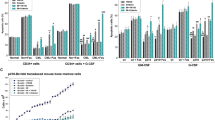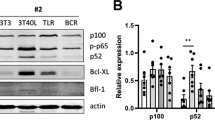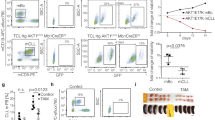Abstract
The progressive rise of mature CD5+ B lymphocytes, despite the low proportion of proliferating cells, has led to the notion that B cell chronic lymphocytic leukemia (B-CLL) is primarily related to defective apoptosis. The microenvironment likely plays a prominent role because the malignant cells progressively accumulate in vivo, whereas they rapidly undergo spontaneous apoptosis when cultured in vitro. To assess microenvironment-mediated survival signals, B-CLL cells were cultured with a murine fibroblast cell line, Ltk−, with and without an agonistic antibody to CD40. Spontaneous apoptosis was associated with the loss of Akt and NF-κB activities. Interactions with fibroblasts sustained a basal level of Akt and NF-κB activities, which was dependent on phosphatidylinositol-3 kinase (PI3K). Constitutive activity of the PI3K pathway in B-CLL cells when cultured with fibroblasts prevented the downregulation of the prosurvival Bcl-2 family protein Bcl-xL and the caspase inhibitor proteins FLIPL and XIAP, and consequently caspase-3 activation and apoptosis. CD40 crosslinking in B-CLL cells did not further prevent murine fibroblasts-mediated apoptosis but induced cell proliferation, which was associated with an increase of Akt and NF-κB activation compared with cells cultured with fibroblasts alone. The PI3K pathway seems to play a pivotal role in B-CLL cell survival and growth.
This is a preview of subscription content, access via your institution
Access options
Subscribe to this journal
Receive 12 print issues and online access
$259.00 per year
only $21.58 per issue
Buy this article
- Purchase on Springer Link
- Instant access to full article PDF
Prices may be subject to local taxes which are calculated during checkout







Similar content being viewed by others
References
Rozman C, Montserrat E . Chronic lymphocytic leukemia. N Engl J Med 1995; 333: 1052–1057.
Freedman AS, Boyd AW, Bieber FR, Daley J, Rosen K, Horowitz JC et al. Normal cellular counterparts of B cell chronic lymphocytic leukemia. Blood 1987; 70: 418–427.
Bannerji R, Byrd JC . Update on the biology of chronic lymphocytic leukemia. Curr Opin Oncol 2000; 12: 22–29.
Collins RJ, Verschuer LA, Harmon BV, Prentice RL, Pope JH, Kerr JF . Spontaneous programmed death (apoptosis) of B-chronic lymphocytic leukaemia cells following their culture in vitro. Br J Haematol 1989; 71: 343–350.
Panayiotidis P, Jones D, Ganeshaguru K, Foroni L, Hoffbrand AV . Human bone marrow stromal cells prevent apoptosis and support the survival of chronic lymphocytic leukaemia cells in vitro. Br J Haematol 1996; 92: 97–103.
Lagneaux L, Delforge A, Bron D, De BC, Stryckmans P . Chronic lymphocytic leukemic B cells but not normal B cells are rescued from apoptosis by contact with normal bone marrow stromal cells. Blood 1998; 91: 2387–2396.
Burger JA, Tsukada N, Burger M, Zvaifler NJ, Dell'Aquila M, Kipps TJ . Blood-derived nurse-like cells protect chronic lymphocytic leukemia B cells from spontaneous apoptosis through stromal cell-derived factor-1. Blood 2000; 96: 2655–2663.
Pedersen IM, Kitada S, Leoni LM, Zapata JM, Karras JG, Tsukada N et al. Protection of CLL B cells by a follicular dendritic cell line is dependent on induction of Mcl-1. Blood 2002; 100: 1795–1801.
Banchereau J, Bazan F, Blanchard D, Briere F, Galizzi JP, Van Kooten C et al. The CD40 antigen and its ligand. Annu Rev Immunol 1994; 12: 881–922.
Liu YJ, Johnson GD, Gordon J, MacLennan IC . Germinal centres in T-cell-dependent antibody responses. Immunol Today 1992; 13: 17–21.
Fluckiger AC, Rossi JF, Bussel A, Bryon P, Banchereau J, Defrance T . Responsiveness of chronic lymphocytic leukemia B cells activated via surface Igs or CD40 to B-cell tropic factors. Blood 1992; 80: 3173–3181.
Osorio LM, Aguilar-Santelises M . Apoptosis in B-chronic lymphocytic leukaemia. Med Oncol 1998; 15: 234–240.
Granziero L, Ghia P, Circosta P, Gottardi D, Strola G, Geuna M et al. Survivin is expressed on CD40 stimulation and interfaces proliferation and apoptosis in B-cell chronic lymphocytic leukemia. Blood 2001; 97: 2777–2783.
Banchereau J, de Paoli P, Valle A, Garcia E, Rousset F . Long-term human B cell lines dependent on interleukin-4 and antibody to CD40. Science 1991; 251: 70–72.
Buske C, Gogowski G, Schreiber K, Rave FM, Hiddemann W, Wormann B . Stimulation of B-chronic lymphocytic leukemia cells by murine fibroblasts, IL-4, anti-CD40 antibodies, and the soluble CD40 ligand. Exp Hematol 1997; 25: 329–337.
Datta SR, Brunet A, Greenberg ME . Cellular survival: a play in three Akts. Genes Dev 1999; 13: 2905–2927.
Durie FH, Fava RA, Foy TM, Aruffo A, Ledbetter JA, Noelle RJ . Prevention of collagen-induced arthritis with an antibody to gp39, the ligand for CD40. Science 1993; 261: 1328–1330.
Alessi DR, James SR, Downes CP, Holmes AB, Gaffney PR, Reese CB et al. Characterization of a 3-phosphoinositide-dependent protein kinase which phosphorylates and activates protein kinase Balpha. Curr Biol 1997; 7: 261–269.
Stokoe D, Stephens LR, Copeland T, Gaffney PR, Reese CB, Painter GF et al. Dual role of phosphatidylinositol-3,4,5-trisphosphate in the activation of protein kinase B. Science 1997; 277: 567–570.
Datta SR, Dudek H, Tao X, Masters S, Fu H, Gotoh Y et al. Akt phosphorylation of BAD couples survival signals to the cell-intrinsic death machinery. Cell 1997; 91: 231–241.
Cardone MH, Roy N, Stennicke HR, Salvesen GS, Franke TF, Stanbridge E et al. Regulation of cell death protease caspase-9 by phosphorylation. Science 1998; 282: 1318–1321.
Kops GJ, Burgering BM . Forkhead transcription factors are targets of signalling by the proto-oncogene PKB (C-AKT). J Anat 2000; 4: 571–574.
Beraud C, Henzel WJ, Baeuerle PA . Involvement of regulatory and catalytic subunits of phosphoinositide 3-kinase in NF-kappaB activation. Proc Natl Acad Sci USA 1999; 96: 429–434.
Romashkova JA, Makarov SS . NF-kappaB is a target of AKT in anti-apoptotic PDGF signalling. Nature 1999; 401: 86–90.
Kane LP, Shapiro VS, Stokoe D, Weiss A . Induction of NF-kappaB by the Akt/PKB kinase. Curr Biol 1999; 9: 601–604.
Ghosh S, May MJ, Kopp EB . NF-kappa B and Rel proteins: evolutionarily conserved mediators of immune responses. Annu Rev Immunol 1998; 16: 225–260.
Franke TF, Kaplan DR, Cantley LC . PI3K: downstream AKTion blocks apoptosis. Cell 1997; 88: 435–437.
Karin M, Ben Neriah Y . Phosphorylation meets ubiquitination: the control of NF-[kappa]B activity. Annu Rev Immunol 2000; 18: 621–663.
Madrid LV, Wang CY, Guttridge DC, Schottelius AJ, Baldwin Jr S, Mayo MW . Akt suppresses apoptosis by stimulating the transactivation potential of the RelA/p65 subunit of NF-kappaB. Mol Cell Biol 2000; 20: 1626–1638.
Deveraux QL, Roy N, Stennicke HR, Van Arsdale T, Zhou Q, Srinivasula SM et al. IAPs block apoptotic events induced by caspase-8 and cytochrome c by direct inhibition of distinct caspases. EMBO J 1998; 17: 2215–2223.
Yeh JH, Hsu SC, Han SH, Lai MZ . Mitogen-activated protein kinase kinase antagonized fas-associated death domain protein-mediated apoptosis by induced FLICE-inhibitory protein expression. J Exp Med 1998; 188: 1795–1802.
Panka DJ, Mano T, Suhara T, Walsh K, Mier JW . Phosphatidylinositol 3-kinase/Akt activity regulates c-FLIP expression in tumor cells. J Biol Chem 2001; 276: 6893–6896.
Kazama H, Yonehara S . Oncogenic K-Ras and basic fibroblast growth factor prevent Fas-mediated apoptosis in fibroblasts through activation of mitogen-activated protein kinase. J Cell Biol 2000; 148: 557–566.
Micheau O, Lens S, Gaide O, Alevizopoulos K, Tschopp J . NF-kappaB signals induce the expression of c-FLIP. Mol Cell Biol 2001; 21: 5299–5305.
Wang CY, Guttridge DC, Mayo MW, Baldwin ASJ . NF-kappaB induces expression of the Bcl-2 homologue A1/Bfl-1 to preferentially suppress chemotherapy-induced apoptosis. Mol Cell Biol 1999; 19: 5923–5929.
Sevilla L, Zaldumbide A, Pognonec P, Boulukos KE . Transcriptional regulation of the bcl-x gene encoding the anti-apoptotic Bcl-xL protein by Ets, Rel/NFkappaB, STAT and AP1 transcription factor families. Histol Histopathol 2001; 16: 595–601.
Lee HH, Dadgostar H, Cheng Q, Shu J, Cheng G . NF-kappaB-mediated up-regulation of Bcl-x and Bfl-1/A1 is required for CD40 survival signaling in B lymphocytes. Proc Natl Acad Sci USA 1999; 96: 9136–9141.
Furman RR, Asgary Z, Mascarenhas JO, Liou HC, Schattner EJ . Modulation of NF-kappa B activity and apoptosis in chronic lymphocytic leukemia B cells. J Immunol 2000; 164: 2200–2206.
Dorado B, Portoles P, Ballester S . NF-kappaB in Th2 cells: delayed and long-lasting induction through the TCR complex. Eur J Immunol 1998; 28: 2234–2244.
Kahn-Perles B, Lipcey C, Lecine P, Olive D, Imbert J . Temporal and subunit-specific modulations of the Rel/NF-kappaB transcription factors through CD28 costimulation. J Biol Chem 1997; 272: 21774–21783.
Zhang XH, Li L, Choe J, Krajewski S, Reed JC, Thompson C et al. Up-regulation of Bcl-xL expression protects CD40-activated human B cells from Fas-mediated apoptosis. Cell Immunol 1996; 173: 149–154.
Ishida T, Kobayashi N, Tojo T, Ishida S, Yamamoto T, Inoue J . CD40 signaling-mediated induction of Bcl-XL, Cdk4, and Cdk6. Implication of their cooperation in selective B cell growth. J Immunol 1995; 155: 5527–5535.
Giancotti FG, Ruoslahti E . Integrin signaling. Science 1999; 285: 1028–1032.
Schlaepfer DD, Hauck CR, Sieg DJ . Signaling through focal adhesion kinase. Prog Biophys Mol Biol 1999; 71: 435–478.
Khwaja A, Rodriguez VP, Wennstrom S, Warne PH, Downward J . Matrix adhesion and Ras transformation both activate a phosphoinositide 3-OH kinase and protein kinase B/Akt cellular survival pathway. EMBO J 1997; 16: 2783–2793.
Le Gall M, Chambard JC, Breittmayer JP, Grall D, Pouyssegur J, Obberghen-Schilling E . The p42/p44 MAP kinase pathway prevents apoptosis induced by anchorage and serum removal. Mol Biol Cell 2000; 11: 1103–1112.
Chow SC, Orrenius S . Rapid cytoskeleton modification in thymocytes induced by the immunotoxicant tributyltin. Toxicol Appl Pharmacol 1994; 127: 19–26.
Shin I, Yakes FM, Rojo F, Shin NY, Bakin AV, Baselga J et al. PKB/Akt mediates cell-cycle progression by phosphorylation of p27(Kip1) at threonine 157 and modulation of its cellular localization. Nat Med 2002; 8: 1145–1152.
Liang J, Zubovitz J, Petrocelli T, Kotchetkov R, Connor MK, Han K et al. PKB/Akt phosphorylates p27, impairs nuclear import of p27 and opposes p27-mediated G1 arrest. Nat Med 2002; 8: 1153–1160.
Medema RH, Kops GJ, Bos JL, Burgering BM . AFX-like Forkhead transcription factors mediate cell-cycle regulation by Ras and PKB through p27kip1. Nature 2000; 404: 782–787.
Ahmed NN, Grimes HL, Bellacosa A, Chan TO, Tsichlis PN . Transduction of interleukin-2 antiapoptotic and proliferative signals via Akt protein kinase. Proc Natl Acad Sci USA 1997; 94: 3627–3632.
Berra E, Diaz-Meco MT, Moscat J . The activation of p38 and apoptosis by the inhibition of Erk is antagonized by the phosphoinositide 3-kinase/Akt pathway. J Biol Chem 1998; 273: 10792–10797.
Gibbs BF, Grabbe J . Inhibitors of PI 3-kinase and MEK kinase differentially affect mediator secretion from immunologically activated human basophils. J Leukocyte Biol 1999; 65: 883–890.
Lopez-Cabrera M, Munoz E, Blazquez MV, Ursa MA, Santis AG, Sanchez-Madrid F . Transcriptional regulation of the gene encoding the human C-type lectin leukocyte receptor AIM/CD69 and functional characterization of its tumor necrosis factor-alpha-responsive elements. J Biol Chem 1995; 270: 21545–21551.
Romano MF, Lamberti A, Tassone P, Alfinito F, Costantini S, Chiurazzi F et al. Triggering of CD40 antigen inhibits fludarabine-induced apoptosis in B chronic lymphocytic leukemia cells. Blood 1998; 92: 990–995.
Ghia P, Granziero L, Chilosi M, Caligaris-Cappio F . Chronic B cell malignancies and bone marrow microenvironment. Semin Cancer Biol 2002; 12: 149–155.
Ghia P, Caligaris-Cappio F . The indispensable role of microenvironment in the natural history of low-grade B-cell neoplasms. Adv Cancer Res 2000; 79: 157–173.
Foy TM, Aruffo A, Bajorath J, Buhlmann JE, Noelle RJ . Immune regulation by CD40 and its ligand GP39. Annu Rev Immunol 1996; 14: 591–617.
Bernal A, Pastore RD, Asgary Z, Keller SA, Cesarman E, Liou HC et al. Survival of leukemic B cells promoted by engagement of the antigen receptor. Blood 2001; 98: 3050–3057.
Chen C, Edelstein LC, Gelinas C . The Rel/NF-kappaB family directly activates expression of the apoptosis inhibitor Bcl-x(L). Mol Cell Biol 2000; 20: 2687–2695.
Yang YL, Li XM . The IAP family: endogenous caspase inhibitors with multiple biological activities. Cell Res 2000; 10: 169–177.
Hennino A, Berard M, Krammer PH, Defrance T . FLICE-inhibitory protein is a key regulator of germinal center B cell apoptosis. J Exp Med 2001; 193: 447–458.
Schmid C, Isaacson PG . Proliferation centres in B-cell malignant lymphoma, lymphocytic (B-CLL): an immunophenotypic study. Histopathology 1994; 24: 445–451.
Caligaris-Cappio F, Hamblin TJ . B-cell chronic lymphocytic leukemia: a bird of a different feather. J Clin Oncol 1999; 17: 399–408.
Rossi A, Kapahi P, Natoli G, Takahashi T, Chen Y, Karin M et al. Anti-inflammatory cyclopentenone prostaglandins are direct inhibitors of IkappaB kinase. Nature 2000; 403: 103–108.
Adams J, Palombella VJ, Elliott PJ . Proteasome inhibition: a new strategy in cancer treatment. Invest New Drugs 2000; 18: 109–121.
Murray RZ, Norbury C . Proteasome inhibitors as anti-cancer agents. Anticancer Drugs 2000; 11: 407–417.
Acknowledgements
We thank the contribution to the study of B Contreras, I Losada, T Martín, I Martín-Larrauri, and S Rosado from Fundación LAIR; MJ Citores and C Puerta from Hospital Puerta de Hierro; and A Maraver and JF Rodríguez from Centro Nacional de Biotecnología; and Marta Pulido, MD, for editing the manuscript and editorial assistance. This work was supported by Fundación LAIR, Madrid, Spain.
Author information
Authors and Affiliations
Corresponding author
Rights and permissions
About this article
Cite this article
Cuní, S., Pérez-Aciego, P., Pérez-Chacón, G. et al. A sustained activation of PI3K/NF-κB pathway is critical for the survival of chronic lymphocytic leukemia B cells. Leukemia 18, 1391–1400 (2004). https://doi.org/10.1038/sj.leu.2403398
Received:
Accepted:
Published:
Issue Date:
DOI: https://doi.org/10.1038/sj.leu.2403398
Keywords
This article is cited by
-
HELQ and EGR3 expression correlate with IGHV mutation status and prognosis in chronic lymphocytic leukemia
Journal of Translational Medicine (2021)
-
New roles for B cell receptor associated kinases: when the B cell is not the target
Leukemia (2019)
-
Aberrant splicing of the tumor suppressor CYLD promotes the development of chronic lymphocytic leukemia via sustained NF-κB signaling
Leukemia (2018)
-
Neurotensin receptor type 2 protects B-cell chronic lymphocytic leukemia cells from apoptosis
Oncogene (2018)
-
GeneSCF: a real-time based functional enrichment tool with support for multiple organisms
BMC Bioinformatics (2016)



